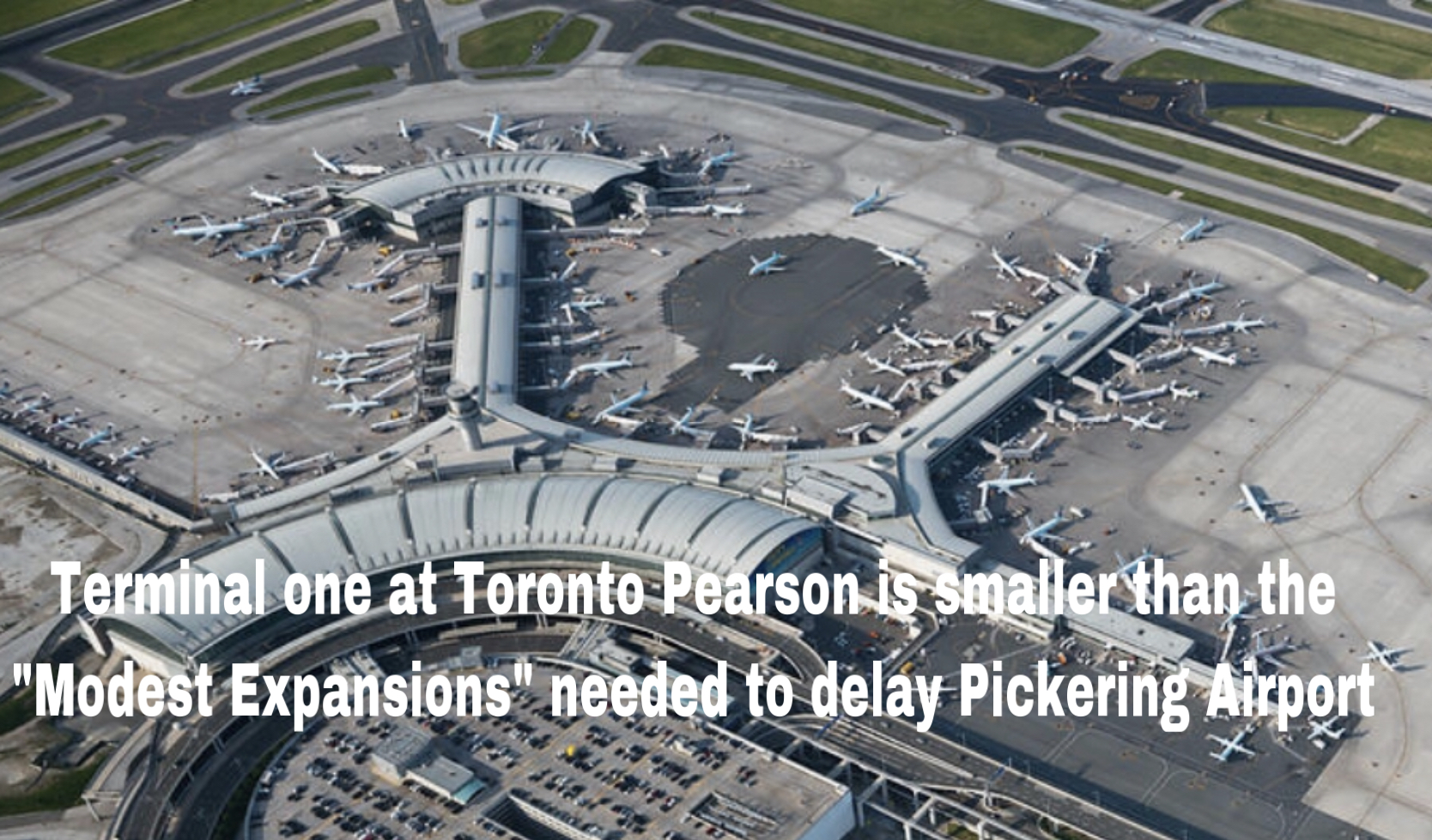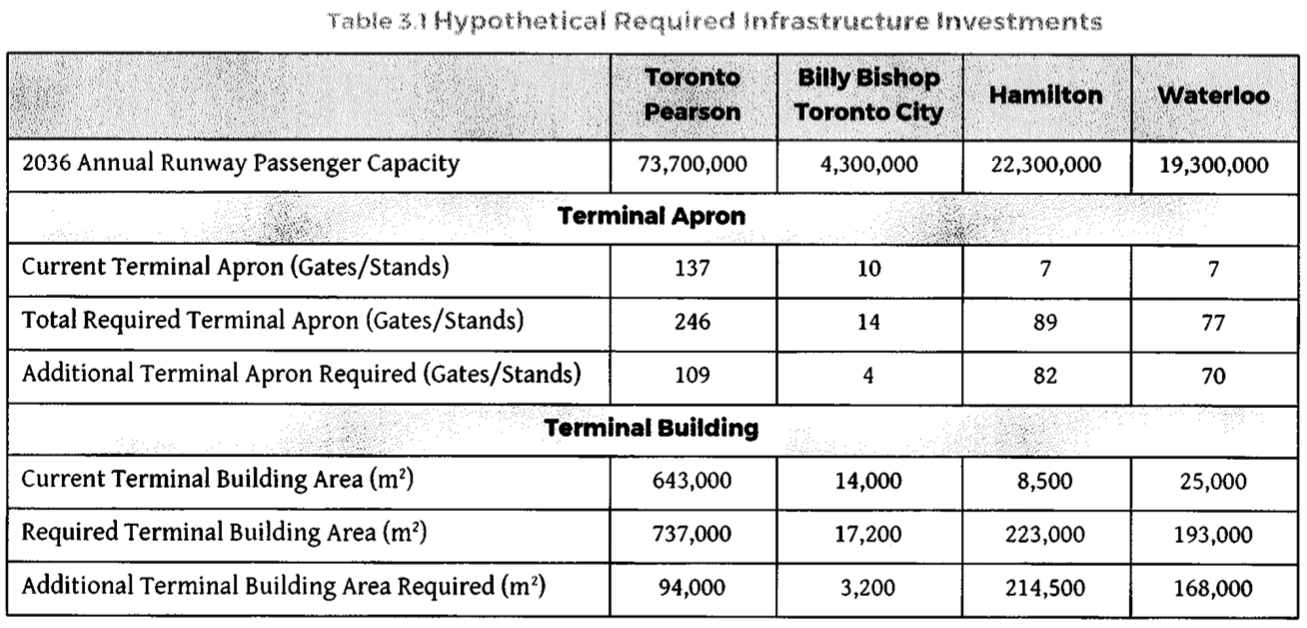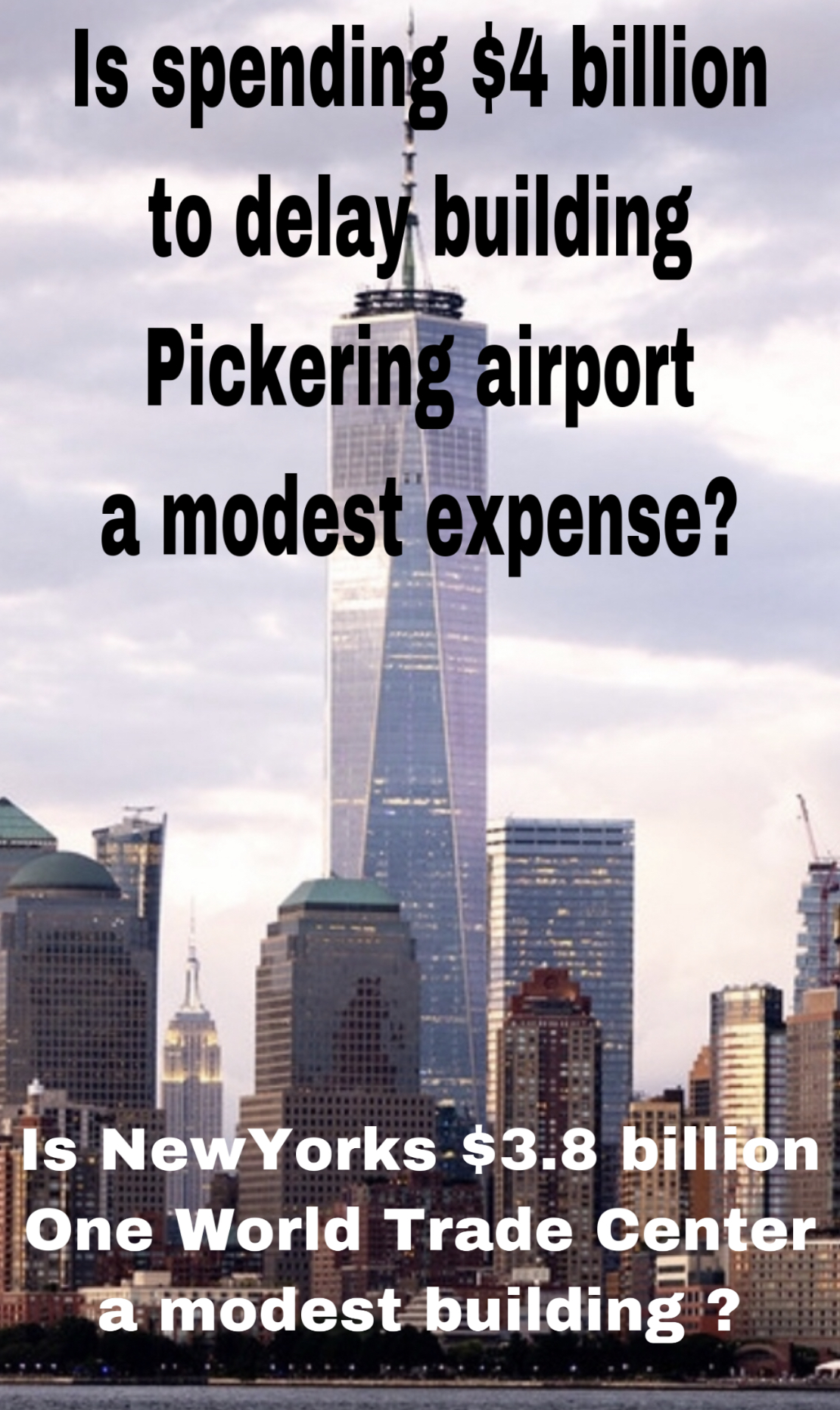The Study commissioned by Transport Canada, Pickering Lands Aviation Sector Analysis, concludes that through “modest expansions in aircraft apron and air terminal facilities”, Pickering Airport’s passenger capacity is not needed before 2036. The Study uses the phrase “modest expansions” to describe billions of dollars of additional aviation facilities that are stunning in both scope and cost. All just to delay the construction of a new airport in Pickering.

The Study concludes that “modest expansions in aircraft apron and air terminal facilities” plus growth below the historical average are needed to postpone building Pickering airport to beyond 2036. In total, four airports (Pearson, Waterloo, Hamilton, Billy Bishop) must find the room and budget for the following additional facilities:
The building of new support facilities, from airport road and rail access, to fuel pipelines, tank farms, and de–icing bays are not mentioned at all.

It appears that the Hamilton and distant Waterloo airports are targeted for the majority of the expansions. Both are several hours drive away from the Eastern Toronto region in need of the new capacity.
To provide context, the Toronto Pearson’s Airport Master Plan identifies that it currently has 128 gates (97 bridge gates plus 31 commuter aircraft stands). The study lists 9 more at a 137. The Study therefore requires the addition of twice as many gates to the network than currently exist at Pearson, the largest commercial airport in Canada.
The graphics (poor quality) in the Study appear to indicate one new terminal is required at Pearson, Waterloo and Hamilton. Those additional terminals and supporting infrastructure are not included in the master plans of these airports and no viable business case is offered.
Commercial passenger terminals are among the most expensive buildings in the world to construct. At the extreme, grand designs by world leading architects, terminals cost thousands of dollars per square foot to build. Terminal One at Pearson is 346,000 m2 and cost $4.4 billion to build twenty years ago. That is more than the $3.8 billion cost of the new One World Trade Center in New York, the tallest building in the western Hemisphere and the pride of a super–power called the United States of America.
At 479,700 m2 or 5,163,000 sf, even the most economical low-cost commercial terminal space will have a capital cost of $4 billion or more. This cost could be doubled again by the costs of new taxiways, aprons to access the new terminals, plus upgrades to road and transit systems serving these airports.
Spending $4 billion and building twice as many new gates before 2036 than currently exist at Pearson can hardly be called “modest expansions”. Yet, the Study says these expansions are required if Pickering Airport is to be delayed.

To its credit, the Pickering Lands Aviation Sector Analysis study stealthily offers a carefully worded critique of the politically convenient “Build Pickering Last” approach. It suggests a real strategy for addressing commercial air traffic in the Toronto region — build Pickering Airport in stages by starting planning now and breaking ground in 2026.
The Study comments (on page 165 and 220) that comparing total system supply and demand should be considered a simplification. It provides a general sense of whether there is capacity elsewhere in the system that can relieve any identified airport capacity constraints within the 20-year study horizon. It goes on to say that transferring air traffic between southern Ontario airports is a theoretical exercise that may not solve operational challenges if one airport is severely constrained, nor may those actions be acceptable to the airlines, the airports and the future passengers expected, if not required, to change their practices because of this air traffic allocation.
In short, adding a two–hour drive to, or a two–hour drive home for a passenger after landing at a distance airport is not an efficient or viable solution. Building locally accessible aviation capacity in Pickering is a solution that has a viable business case.
Considering that through the Study’s stakeholder engagement, the airports, politicians, industry and local groups supported the development of Pickering Airport, it is reasonable to suggest that the espoused Study strategy, i.e. “Build Pickering Last”, would not be viewed favourably by those parties.
The Study’s Better Strategy indicates development of the Pickering Lands, and Pickering Airport, could:
This is a superior strategy, focused on generating economic benefits and the creation of jobs. It is supported by a 135–page business case done by a world–class accounting team. The use of the term “modest” to describe a $4 billion dollar opposing strategy that is unsupported by any business case can only be interpreted as a satirical comment.
The Study has provided the facts needed to base the decision on when to proceed with development of Pickering Airport. The When is Now.
That $4B leverages off a ton of existing and planned non-aviation infrastructure. This is why you’ll always have a tough time making a sound business case. There is no scenario where Pickering can deliver the same capacity once the cost of all the access infrastructure is included. What’s the plan to compete with say $11B Union West that includes VIA High Frequency Rail, GO Regional Express Rail, the Finch West and Eglinton West LRTs and MiWay/GO Busway converging on it? Not to mention all the highways converging on Pearson.
An access plan for Pickering based entirely on driving means that depending on where one lives in Durham and traffic conditions, it could actually be faster in a decade to take GO RER to Union and UPE to Pearson from there. That’s not so much a flaw of the airport as it is a flaw of Durham’s ability to provide transit.
Most tellingly there’s not even advocacy for an HFR stop from Durham while they are salivating over the idea in Peterborough and aggressively campaigning for a REM connection to meet the HFR at Dorval (which would drastically improve air-rail connections). Under these plans, traveling from Montreal becomes quite a bit easier for a lot of Eastern Ontario. Easier than Pearson. Meanwhile, you and other Pickering airport advocates are still fixated on getting people drive to the your airport…..
no, The GTAAs plans for Pearson are already taken into account, although the lack of mention of the effort and billion of $ required to maximize Pearson’s capacity is a notable assumption in the KPMG report.
The $4 billion in expansions is proposed mostly for Hamilton and Waterloo. Both Of these airport authorities have declined to include the expansion listed in the report in their masterplans. With out these expansions in Waterloo and Hamilton Pickering airport must be built.
Not even mentioned in the report are the rail line and jet fuel pipeline extensions that will need to be built to support expansions at Hamilton and Waterloo. The tyranny of geography and logistics rules all.